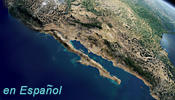![[Ocean Oasis Conservation]](images/bnr-conservation.gif)

![[Ocean Oasis Conservation]](images/bnr-conservation.gif) |  |
![[A History of Conservation Efforts in the Gulf of California]](images/history.gif)
|
|
|
|
In the early 1970s, roughly at the time of Lindbergh's trip to Mexico City, many changes were occurring within the Mexican scientific and conservation groups. These scientific transformations also helped to protect the islands. In 1974 the Instituto de Ecología, A.C. (Institute of Ecology, a non-profit research organization) was created in Mexico City, and soon after it started to promote the concept of biosphere reserves in the country. Although fairly well accepted at present, the idea of Biosphere Reserves, which had been developed by a group of ecologists in UNESCO's Man and the Biosphere Program (MAB), was radically new in 1975. Biosphere Reserves were conceived as natural protected areas where the indigenous populations living inside the area or in the surrounding "buffer zones" were encouraged to use their natural resources in a sustainable manner. The new approach departed radically from the "natural park" concept, which basically advocates for pristine areas free of human influence. Rather, biosphere reserves promoted sustainable use as an effective tool for conservation. Many of the concepts discussed at the Rio Summit (UNCED) in 1992 were already operational in MAB's concept of Biosphere Reserves almost 20 years before, including the:
Three Mexican biosphere reserves were among the first in the world to become part of the MAB network of biosphere reserves. One of these reserves was in the Chihuahuan desert, in the arid north of the country. This simple fact created consciousness among decision-makers in the Federal Government that protected areas could be created in what was previously perceived as barren wastelands (previously, National Parks in Mexico had been located almost unfailingly in montane areas with temperate forests). Additionally, the international success of the Mexican Biosphere Reserves caught the attention of the environmental authorities, which realized that large natural areas could be protected under the new scheme as it did not preclude resource use but rather pursued an adequate utilization. Although the Islands of the Gulf of California were initially not conceived as a Biosphere Reserve but rather as a wildlife refuge, it was in the wake of these changes that the decree protecting them was issued in 1978 (DOF 1978).
Continue to |
|
Text adapted from the conservation chapter of the book Island Biogeography in the Sea of Cortés, a forthcoming volume edited by Ted Case, Martin Cody, and Exequiel Ezcurra. The chapter was authored by Luis Bourillon, Antonio Cantú, Exequiel Ezcurra, María Elena Martínez, and Alejandro Robles. |
Conservation | Site Index | Ocean Oasis
San Diego Natural History Museum & PRONATURA
© 2000 CinemaCorp of the Californias